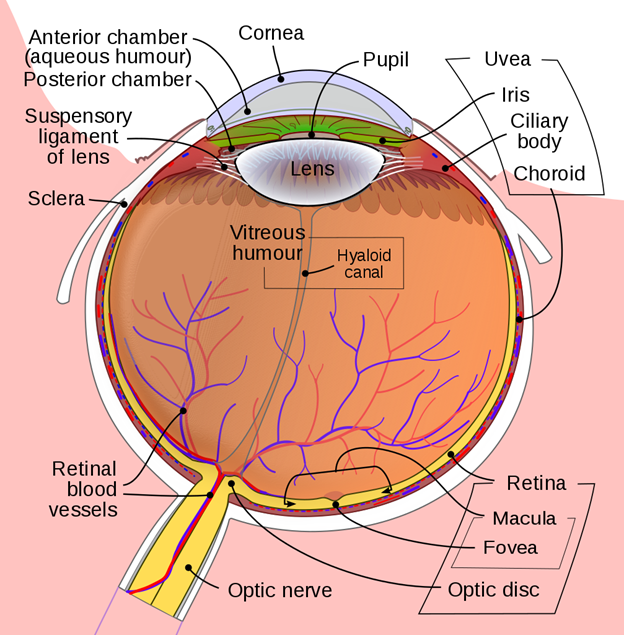How We See: The Human Visual System
The ultimate goal of any video technology is (or should be...) to reproduce as faithfully as possible, given all driving factors, the image captured by the camera. In other words, to project an image to the eye of the viewer which is of such fidelity that it matches what that viewer would see were they standing in the exact location that the camera was at, looking at the exact scene that the camera was focused on, at the exact time that the camera registered the image.
I am, of course, ignoring special effects, color grading for effect, CGI etc.—though to the extent that they include “live action,” their task is to blend invisibly into that scene and enhance the story, so a similar argument can be made in many cases. It is certainly the goal of HDR, WCG (Wide Color Gamut, which is often inferred when talking about HDR, although it’s actually a different topic), resolutions of 4K/UHD and above, and HFR (High Frame Rate). There are pragmatic limits to this, of course: if you really were at the scene, there would also be infra-red and ultra-violet energy present, but you can’t see it—so there’s no point in retaining it through the media delivery chain.
THE LAST COMPONENT IN THE DELIVERY CHAIN
While I was preparing for this next post—which was to be on the topic of light levels, both artificial and naturally occurring, it occurred to me that there might be some background information that you, the reader, might find instructive. As engineers, we tend to focus our attention on all of the technical aspects of our end to end system. But it would be wise for us to have some understanding of how humans see—after all, the Human Visual System (HVS) is really the last component in our delivery chain, is it not?

In this posting then, we’ll look at some of the attributes of the Human Visual System. It is a very deep and ongoing topic, and I am woefully under-qualified to go into a deep dive, but hopefully you will find this information useful. I’ll give you a link at the end of the post for you to use as a starting point if you want to research the topic in more detail yourself – there’s plenty of information out there, you just need to know where to start!
[Read: HDR: What Is It And Why Do We Need It?]
The human eye is thought by many to actually be a direct extension of the brain, rather than a completely separate organ, for many reasons, one of which will become clear in a moment. We are all taught that the retina is composed of rods and cones—the rods are generally used for low-light vision, and the cones are used for daylight and brightly-colored vision. These are not evenly distributed about the retina, however. There is a small area of the retina—approximately 0.2mm in diameter—where more than half of the total retinal cones are located (and, conversely, no rods are located). This area is called the , and it is this area that is specialized for sharp, daylight vision (look at the diagram—the fovea is that tiny dot at roughly the 6 o’clock position).
‘SACCADIC MOTION’
This responsiveness of this area also sets the limit on human visual acuity. On hearing this information, most people ask: “but I can see detail over a large part of my visual field—how is that possible with such a small detection area?” The answer to that is that your eyes are constantly moving via something called “saccadic motion” so that the fovea is focused on a slightly different part of your visual field, and your brain stitches this information together to create the overall image that you see. The brain directs these saccadic motions in the case of fixation on an item that is moving, but the eye performs the saccadic motions itself when the item of fixation is at rest—a largely autonomous activity, which strengthens the idea that the eye is an extension of the brain.
While the fovea is heavily involved in the detection of bright light, it is not used in very low-light situations. That is the responsibility of the retinal rods, which exist everywhere in the fovea (and that’s why color resolution is so much lower in low-light situations: you have far fewer cones/mm in the rest of the retina). So our ability to view those beautiful HDR, WCG (Wide Color Gamut)—and even UHD and up—is entirely dependent on a section of the eye that is just 0.2mm in diameter! Food for thought when you’re considering that 72-inch 8K HDR TV set…
There are, of course, many other parts of the eye that are critical to our ability to resolve images, most of which we have a passing understanding of, but the fovea, to me, is the unsung hero of the whole thing.
Hopefully, I’ve sparked enough interest for you to do a little research of your own into this fascinating topic. If I have, I would suggest you start with a paper called “How the retina works” by Helga Kolb. You can find it at here. It covers a lot of the data in (largely) plain language and can serve as a jumping off point for hours of interesting study. Enjoy!
Paul Turner is founder ofTurner Media Consultingand can be reached atpault@turnerconsulting.tv
Get the TV Tech Newsletter
The professional video industry's #1 source for news, trends and product and tech information. Sign up below.
